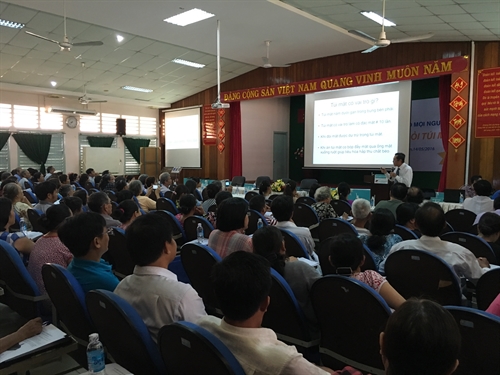 Society
Society

People aged more than 40, especially women, should have a low-fat, high-fibre diet to avoid conditions like gallbladder stones, doctors told a workshop in HCM City.
 |
| Bình Dân Hospital last Saturday held a counselling workshop on the prevention, diagnosis and treatment of gallbladder stones and post-surgery care. — VNS/ Photo courtesy Bình Dân Hospital. |
HCM CITY— People aged more than 40, especially women, should have a low-fat, high-fibre diet to avoid conditions like gallbladder stones, doctors told a workshop in HCM City.
Speaking at what was a counselling session on Saturday at Bình Dân Hospital in District 3, Dr Nguyễn Cao Cương of the hospital’s liver and gallbladder surgery ward said people are more likely to develop stones in the gallbladder after 40, and women are at higher risk.
Other doctors said pregnancy and birth control pills could increase estrogen secretion in women, which is likely to raise cholesterol levels in bile and decrease gallbladder contractions, leading to the risk of stones.
Cương said most patients with stones do not know they have it because there are no symptoms, and they are discovered only by chance through abdominal ultrasound and x-ray.
Drugs are not prescribed usually for dissolving gallstones because of their low effectiveness and many side effects, he said.
On the other hand, stones that cause a sudden and intense pain in the upper right abdomen are treated by removing the gallbladder, he said.
Of patients with gallbladder stones, only 2 per cent develop pain within a year. The figure increases to 15 per cent over 10 years.
If the pain is not treated in time, it could create complications such as acute cholecystitis which causes serious infection or injury to the gallbladder and even death.
The gallbladder should be removed through laparoscopic surgery, which is common in Việt Nam, to avoid a recurrence of the stones, he said.
“If the stones are taken out without removing the gallbladder, 50 per cent of patients could get stones again after two years.”
Dr Võ Văn Hùng, the ward’s deputy head, said his hospital performs 1,000-1,200 surgeries each year for gallbladder stones.
A screening programme in 30 wards in the city more than 10 years ago found 6.44 per cent of the population had stones. — VNS